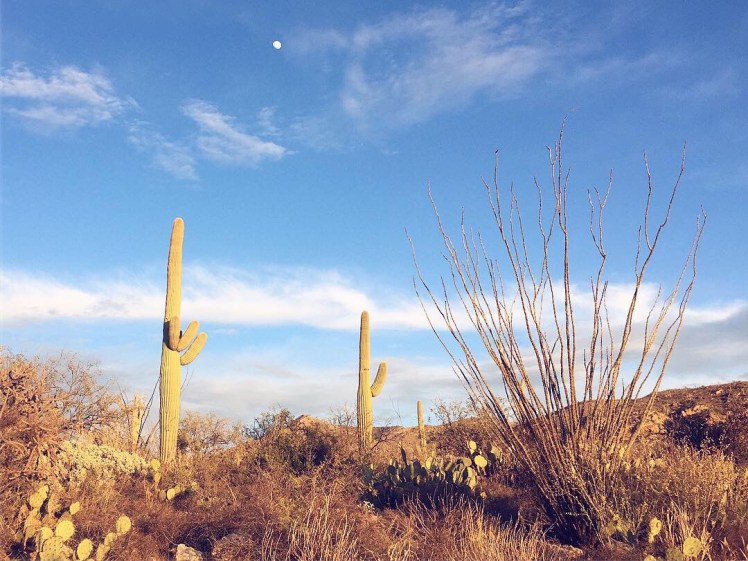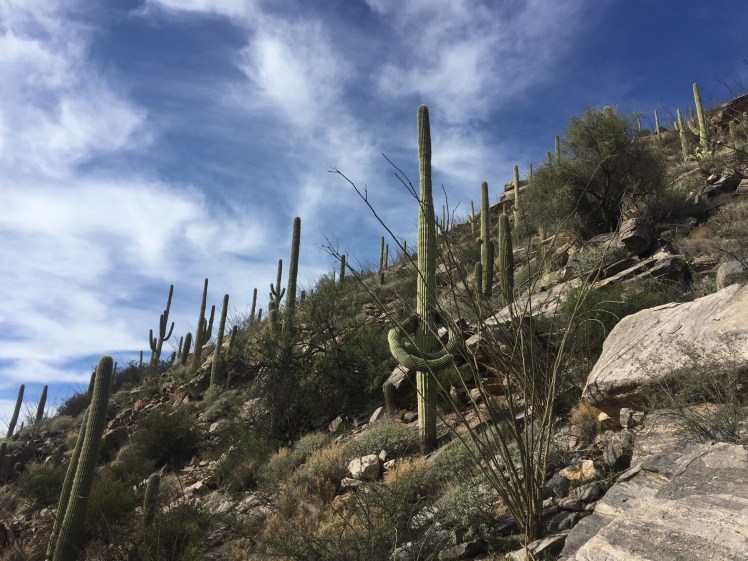Sara Aranda
The more we are lost to an unknown, the more we emerge as something different. The older we are, the more we wish to slow our pace and time. And yet, the more we live, the more writhed we become — the more we house both our greatest gifts and wounds.
There’s a Tohono O’odham legend about a lost boy who fell into a hole in the desert. He later emerged as a saguaro.
Across the Desierto de Sonora, millions of saguaros mark the rocky landscape with their ribbed columns. They grow painfully slow and weigh over a ton when fully grown. They tower the desert here. They puncture upwards for hundreds of years. They glow at dusk, burn orange with deep resilience — and the saguaros with the most twisted arms are the ones that seem to capture something within me.

I sweat in the mild heat as I attempt to run up a steep trail. I stop quite often to measure myself against the desert spines. I notice the saguaros with scars and holes dug by large gilded flickers, holes later used by owls or hawks. I hear an owl tu-whoo from somewhere along the reddened cliffs and I hold my breath to listen. When a saguaro dies, the bowled, woody calluses, known in English as boots, are used by indigenous peoples to carry what the cactus once held so preciously. I turn again to continue my rise from Pontatoc Canyon, squeeze water into the bowl of me.
With every switchback and spin of the heels, I can’t believe how much water must exist across this land, so thoroughly tucked into every prickly plant and slow-bursting seed. I continue upwards along the narrow trail—a sliver of benign space between swaths of rich and thorny cholla, ocotillo, eagle claws, prickly-pear, pincushion cacti; and between every cactus is a paloverde tree, creosote bush, yucca plant, wild sage, agave, hierba del vaso with its brittle stems and yellow flowers.

In the midst of the abundance, I am the lone, two-legged thing that trips on stones and bleeds from the shins. The birds flit about the tops of saguaros and the owl still hoots from the desert abyss. I cross the trickling canyon creek and head upslope all the more. The trail thins and I find myself swishing through long bunch grass and needle grama, picking their sharp fruits from my shoes and socks.
The more I rise, the more the saguaros seem scattered and gone. The slope eventually smooths and the rocks no longer protrude. I face the canyon below, see all of Tucson glimmering beyond. The wind rattles the grass and I begin to imagine a stalking thing as tan and as elusive as the wind-thrown sounds themselves. But what does it truly mean to channel the instinct of fear? Of grief? Of resilience?

The legend of the lost boy has origin due to these very artifacts of time and now an entire desert and its people mourn history. Yet, when the birds excavate saguaro pulp, the cactus readily initiates its own process of self-healing. When holes are dug from us, we learn to patch our flesh with dark callus lest we risk lethal depletion. Even if the pecks are small, over time, every drip of the soul is irreplaceable. So we rise. We must rise, nonetheless. We can only hope that, one day, our tightly woven knots become catalyst for change and further healing, a holistic value that outweighs the very grief itself. Eventually, the stories will change. Eventually, the grief will be scattered and gone, too.
While my grief is different from those who are of this very region, I resonate with every careful step I am asked to take down into the canyon. The saguaros snag my gaze and I can only be made better by it; for every drop of blood the desert takes from me, I am distilled and asked to mind the way I fumble forth in life. To contemplate the way I arrange myself across a landscape and question the way stories are thusly told. It is the saguaro that thrives here. It is the saguaro that should be remembered and held on its own terms. It is the saguaro that tethers its roots to the stones and it is me that runs over them. We are each with instinct and duty for life and yet I do not belong here.
I visit and I am changed and I am to be good at erasing myself, too. At housing and cultivating grief. At emerging from the unknowns of life long enough to understand its brevity. But only time is good at these things. Even the saguaros seem to know that.


Sara this is so beautiful. I have read it a couple of times. I’m so happy I get these emails every so often and I get to read such lovely words.
Alexa
Sent from my iPhone
>
LikeLiked by 1 person
Thank you so much Alexa. 🙂 This has made my day to hear. ❤️
LikeLike